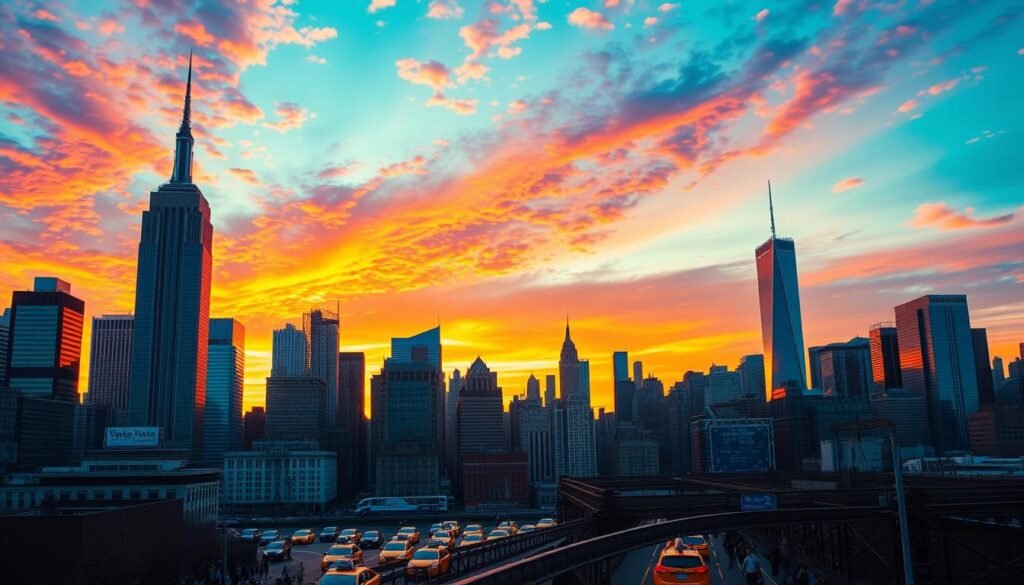New York City is a city that always surprises. It has a famous skyline and busy streets. But there are many stories and secrets that even long-time New Yorkers might not know.
From its many languages to its weird attractions and hidden history, New York is full of surprises. In this article, we’ll explore 50 interesting and curious things about New York. We’ll look at its history, geography, and the amazing facts that make it special.
Key Takeaways
- New York City is home to approximately 1 out of every 38 Americans.
- NYC boasts more linguistic diversity than any other city, with over 800 spoken languages.
- The city’s coastline spans 520 miles, larger than the combined coastlines of Miami, Boston, Los Angeles, and San Francisco.
- Millionaires account for 1 out of every 21 New Yorkers, making it a true millionaires’ paradise.
- NYC was the first capital of the United States, holding the title for five years.
New York's Linguistic Diversity
New York City is a melting pot of languages, with over 800 spoken languages. It’s the most linguistically diverse city globally. This diversity comes from its large immigrant population, where people from everywhere live together.
Walking through New York, you’ll hear many languages. You might hear Spanish, Mandarin, and Cantonese. There are also many other languages like Russian, Arabic, and Bengali. This mix of languages makes New York special and helps its people succeed in the global economy.
New Yorkers have their own way of speaking. They say “coffee” as “cawfee” and “three” as “tree.” They also stress certain sounds differently. This can be confusing for outsiders who aren’t used to New York’s fast and overlapping conversations.
New York’s language scene shows its cultural wealth and importance. From Manhattan to the outer boroughs, the city’s language mix keeps changing. It shows the vibrant spirit of one of the world’s most dynamic cities.
“New York City is the most linguistically diverse place in the world, with over 800 languages spoken within its borders.”
The Birthplace of Iconic Dishes
New York City is where many iconic dishes were born. These dishes are now part of American cuisine. The city’s diverse culture and immigrant communities have shaped its food heritage.
The ice cream cone, eggs benedict, and pasta primavera all have New York roots. These dishes reflect the city’s rich history and cultural mix.
The New York-style pizza is perhaps the most famous. It was first served at Lombardi’s in 1905. This pizza is known for its thin crust and tangy sauce, loved by many.
| Iconic Dish | Origin | Year |
|---|---|---|
| Ice Cream Cone | New York City | N/A |
| Eggs Benedict | Waldorf-Astoria Hotel, New York | N/A |
| Pasta Primavera | New York City | N/A |
| New York-style Pizza | Lombardi’s, New York City | 1905 |
New York City is always changing, and so is its food scene. New dishes will keep coming, showing off the city’s diverse culture. The classics will always be loved, but new favorites will also emerge, exciting food lovers for years to come.
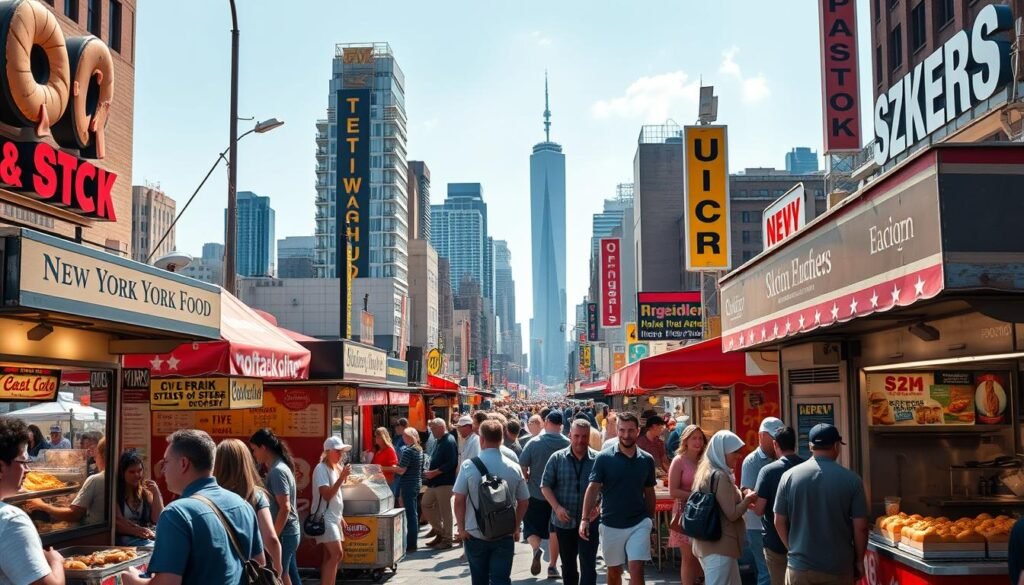
50 interesting and curious things you didn't know about New York
New York City is full of secrets and surprises. Even people who live here might not know some of these cool facts. From its many languages to its weird attractions, the city has a lot to offer. Let’s explore 50 interesting and curious things you didn’t know about New York.
The City's Linguistic Diversity
New York City is the most linguistically diverse place in the world. Over 800 languages are spoken here. Almost half of the households speak more than one language. A third of the people were born in another country, adding to the city’s rich language mix.
Hidden Gems of New York
- The Federal Reserve Bank in New York holds about 25% of the world’s gold. That’s around 7,000 tons.
- Central Park is a bird lover’s dream. It’s home to over 275 different bird species.
- The New York Public Library has hair from famous people like Wild Bill Hickok and Walt Whitman.
Quirky New York Attractions
New York City is known for its unique attractions. Places like the Cloisters in Fort Tryon Park and the Geneology Room at the New York Public Library are must-sees. But did you know there’s a windowless skyscraper in the city? It was built to withstand nuclear fallout.
Fascinating New York Stories
- In 2010, 4 in 10 emergency 911 calls were accidental “butt calls” or “pocket calls.”
- Lightning strikes the Empire State Building about 25 times a year.
- New York City has the most Michelin-starred restaurants outside of Japan.
New York’s diverse population, geography, and landmarks have amazing stories. This article has just started to share some of these fascinating facts. There’s more to discover about this vibrant and dynamic city. Stay tuned for more interesting insights.
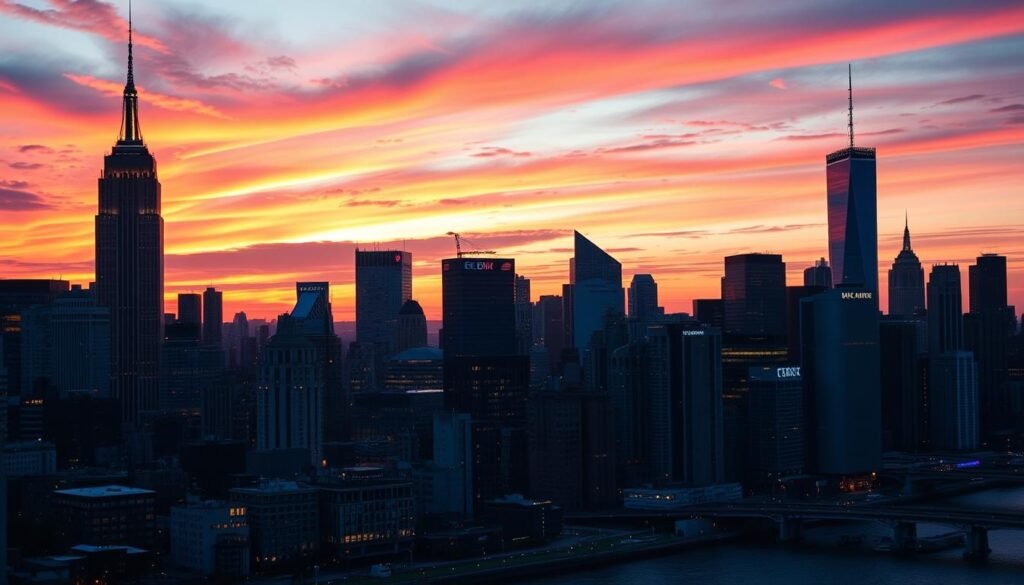
New York's Coastline Beats All
New York City’s coastline stretches an impressive 520 miles. This is longer than the coastlines of Miami, Boston, Los Angeles, and San Francisco combined. The city’s location on the Atlantic Ocean and its many inlets and waterways make its New York City coastline vast. This is a key feature of the Big Apple’s landscape.
Staten Island’s beaches and the Bronx’s marshes show the variety of New York’s coastal geography. They offer many natural environments and fun activities for both locals and tourists. Walking along the NYC coastline size or finding the city’s waterfront secrets is always exciting.
“New York City’s coastline is a testament to the city’s rich natural history and its constant evolution. It’s a place where the urban and the natural coexist in a delicate balance, creating a truly unique and breathtaking landscape.”
The city’s coastline is not just beautiful but also important for its infrastructure and economy. From Manhattan’s busy ports to the fishing communities in the outer boroughs, New York’s coastline is essential. It shapes the city’s identity and future.
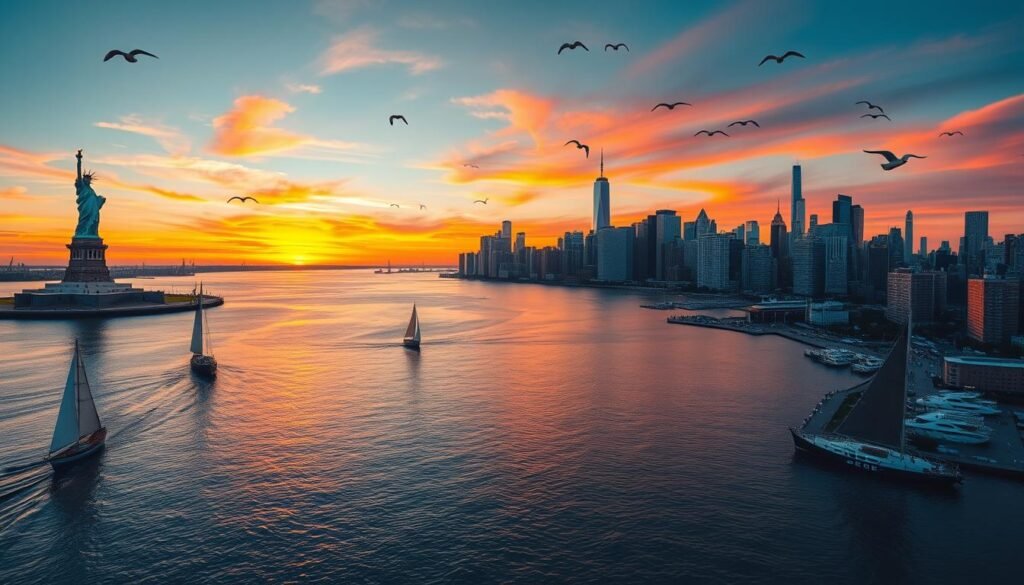
Exploring New York City’s coastline is a must for anyone visiting or living here. The city’s skyline, hidden coves, and beaches are full of natural beauty and adventure. It’s a place where you can always find something new to discover.
The Narrowest House in NYC
New York City is famous for its varied and stunning architecture. But one house is truly remarkable – the narrowest house in the city. It’s located at 75 1/2 Bedford Street in Greenwich Village. This unique New York City architecture is just 9 feet wide, making it one of the most interesting homes in the city.
This small home in NYC has a fascinating history. It once housed many people, showing how New Yorkers can make the most of small spaces. Today, the Narrowest house in New York City is a symbol of the city’s diverse and changing buildings. It draws the interest of both visitors and locals.
| Fact | Statistic |
|---|---|
| Width of the Narrowest House in NYC | 9 feet |
| Location of the Narrowest House | 75 1/2 Bedford Street, Greenwich Village |
| Number of Residents the House Has Accommodated | Several |
The Narrowest house in New York City shows the city’s ability to embrace the unique. It highlights the creativity and determination of its residents. This architectural wonder continues to amaze and inspire everyone who sees it. It offers a peek into the rich world of unique New York City architecture.
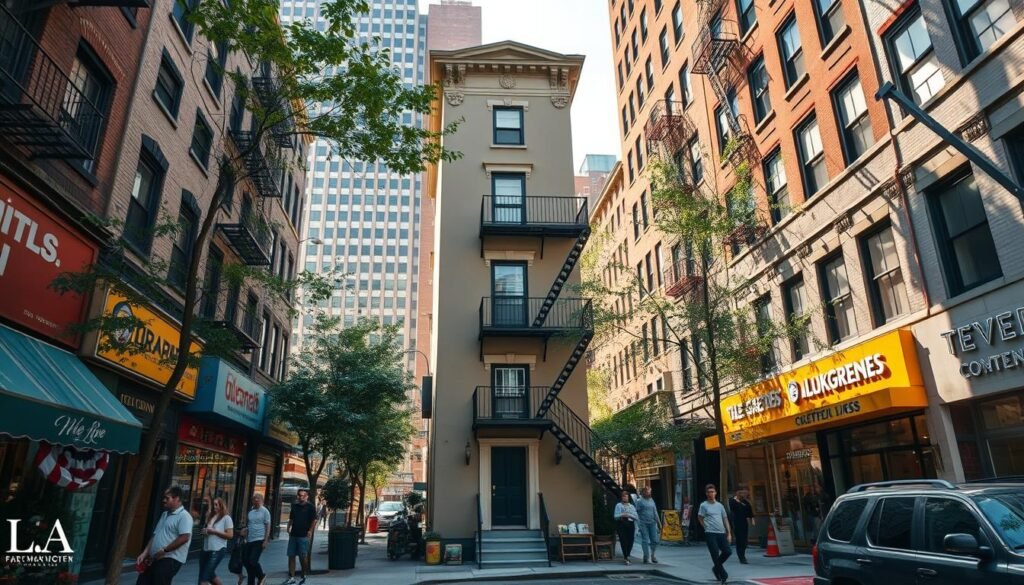
“Despite its small size, the house was once home to several residents. It shows the ingenuity and resourcefulness of New Yorkers in using limited space.”
Millionaires' Paradise
New York City is a true haven for the ultra-wealthy. Millionaires make up 1 out of every 21 residents. This makes the Big Apple a “millionaires’ paradise,” unmatched in the United States.
The city’s economy, cultural amenities, and status as a global financial center attract the affluent. They are drawn to the endless opportunities and luxurious lifestyle New York offers. From Manhattan’s opulent penthouses to the Hamptons’ exclusive enclaves, these New York City millionaires shape the city’s landscape.
With over 107 billionaires, the wealthy residents of NYC significantly impact the city’s economy and social fabric. These high net worth individuals in New York enjoy the city’s amenities and contribute to its vibrancy through philanthropy, investments, and cultural involvement.
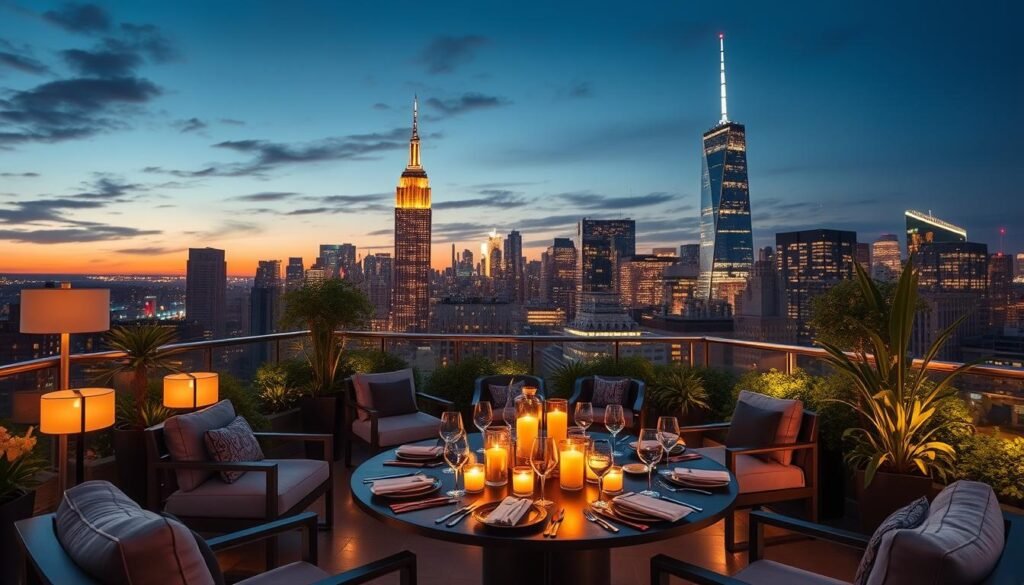
The concentration of millionaires in New York City shows its enduring appeal as a global hub. Whether for endless opportunities or the city’s unparalleled lifestyle, these New York City millionaires continue to shape the Big Apple in profound and fascinating ways.
Hidden Gems of New York's History
Under the skyscrapers and busy streets of New York City’s Financial District, a treasure trove of history waits. A glass floor lets you see the remains of Dutch colonial buildings from 1642. This was when the city was called New Amsterdam under Dutch rule. These hidden historical sites in New York City show us the early days of European settlement and the Dutch influence on the city’s architecture.
The foundations of homes and Dutch colonial architecture in NYC seen through the glass floor tell a story. They show the lasting impact of the city’s first European settlers. These Financial District historical landmarks give us a peek into the city’s beginnings and the history that still shapes it today.
Keeping these architectural pieces safe among the skyscrapers and financial hub shows New York’s dedication to its past and future. As people walk through the Financial District, they can see the city’s hidden history. It’s a powerful reminder of New York’s rich and diverse heritage.

“These hidden historical sites in New York City offer a rare glimpse into the early European settlement of the region and the architectural legacy of the city’s Dutch colonial past.”
New York's Quirky Attractions
New York City has more than just famous landmarks. It’s full of quirky and unusual spots that are often overlooked. These places show the city’s offbeat and eclectic side.
Check out the City Reliquary in Williamsburg. It’s a museum filled with oddities from New York. Or, visit the Skyscraper Museum in Battery Park to learn about the city’s skyscrapers.
For a taste of Coney Island’s history, go to the Coney Island Museum. You’ll see vintage bumper cars and fun house mirrors. The National Museum of Mathematics in NoMad has interactive exhibits on geometry and physics.
See Louis Armstrong’s jazz collection in Queens. Or, explore the Conjuring Arts Research Center in New York. It has over 11,000 books on magic and sleight of hand.
Marvel at the Waterfront Museum’s maritime history. Or, visit the Mmuseumm in Tribeca to see the modern world’s complexities. These spots offer a unique view of New York City’s culture.
| Quirky Attraction | Location | Description |
|---|---|---|
| City Reliquary | Williamsburg, Brooklyn | A storefront museum featuring a permanent collection of unique New York oddities. |
| The Skyscraper Museum | Battery Park, Manhattan | Explores the design, construction, and technology behind famous New York skyscrapers. |
| Coney Island Museum | Coney Island, Brooklyn | Celebrates the history of Coney Island with vintage exhibits like bumper cars and fun house mirrors. |
| National Museum of Mathematics | NoMad, Manhattan | Offers interactive installations focusing on geometry, algorithms, and physics principles. |
| Louis Armstrong House | Queens | Showcases the personal collection of the jazz legend, including 1,600 recordings and memorabilia. |
New York City has more than just the usual tourist spots. It’s full of hidden gems and quirky attractions. These places offer a unique look into the city’s offbeat side.
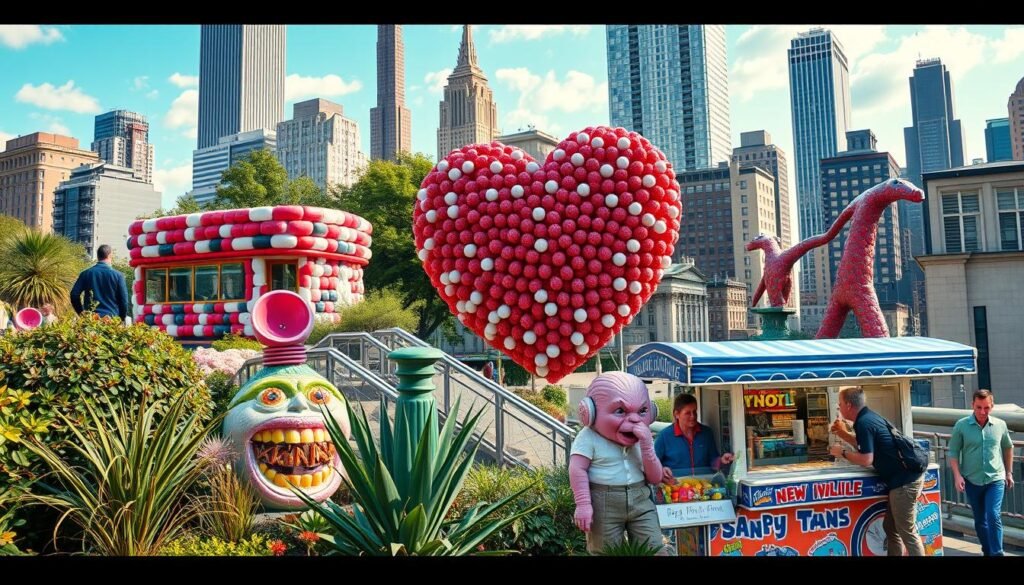
NYC's Intriguing Geography
New York City’s geography is a mix of natural and man-made wonders. It has a 520-mile coastline, bigger than Miami, Boston, Los Angeles, and San Francisco’s coastlines combined. There’s also a 15-story deep hole between 36th and 37th streets on Park Avenue.
The city has the Adirondack Park, bigger than Yellowstone, Yosemite, the Grand Canyon, Glacier, and Olympic Parks together. New York has diverse natural habitats like marshes, beaches, and homes for black bears, bobcats, and moose. This mix of urban and natural landscapes makes NYC special.
| Unique Geographic Features of NYC | Key Facts |
|---|---|
| Expansive Coastline | 520 miles, larger than the combined coastlines of Miami, Boston, Los Angeles, and San Francisco |
| Adirondack Park | Larger than Yellowstone, Yosemite, the Grand Canyon, Glacier, and Olympic Parks combined |
| Natural Habitats | Includes marshes, beaches, and populations of black bear, bobcat, and moose |
| 15-story Deep Hole | Located between 36th and 37th streets on Park Avenue |
This mix of urban and natural landscapes makes NYC’s geography unique. It offers a special experience for both locals and visitors.
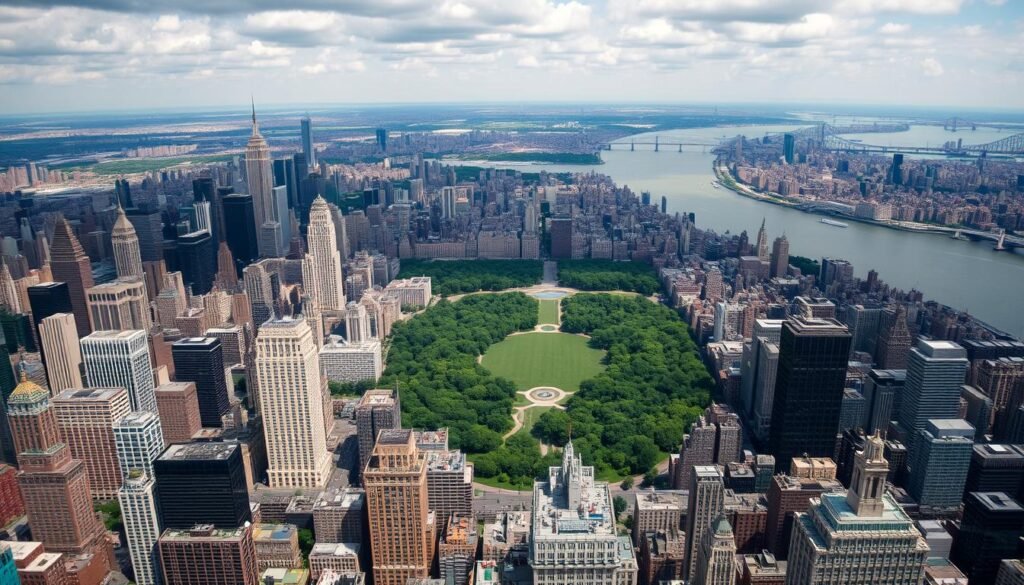
The Underground Subway Ecosystem
Beneath New York City‘s busy streets, a hidden world thrives. The subway system is home to over 15,150 life forms. These include rodents, insects, and bacteria. This diverse group has adapted to the subway’s unique conditions.
This underground ecosystem is complex and often unseen. Millions of commuters use the subway daily, unaware of this hidden world. It shows the resilience and adaptability of life in unexpected places.
The Canal Street Sewer, roofed in 1812, and the West Side Tunnel used by Amtrak, are part of this history. For centuries, underground life in NYC has evolved and thrived.
The New York City subway system is home to a wide variety of organisms. Researchers have found bacteria and even “Mole People.” These individuals have built communities in the subway’s tunnels and passages.
| Organism | Adaptation |
|---|---|
| Rodents | Thriving in the warm, dark environments of the subway tunnels, with abundant food sources from commuter waste. |
| Insects | Diverse species of insects, such as cockroaches and silverfish, have adapted to the subway’s unique ecosystem. |
| Bacteria | Numerous strains of bacteria, some potentially harmful, have found a home in the damp, enclosed spaces of the subway system. |
The ecosystems in the NYC subway show life’s resilience and adaptability. As the city grows, so will this hidden world. It offers a glimpse into the intricate workings of nature.

“The subway is a living, breathing entity, with its own unique microbiome and community of resilient organisms that have carved out a niche for themselves in the most unexpected of places.”
– Duncan, a graduate of Columbia University
Bizarre Laws in the Big Apple
New York City is famous for its landmarks and diverse culture. It’s also known for its weird and old laws. These laws range from banning pinball machines to making farting in church a crime. They show the city’s unique history and quirks.
Farting in a New York City Church: A Misdemeanor
Farting in a church is illegal in New York City. This law dates back to the late 19th century. Breaking it can lead to fines or even jail time.
Another odd law banned pinball machines from 1940 to 1976. This law might have made sense back then. Now, it shows how social norms have changed over time.
These laws give a peek into New York City’s quirky side. They reflect the city’s culture and history. Laws like these make the city interesting to both locals and visitors.
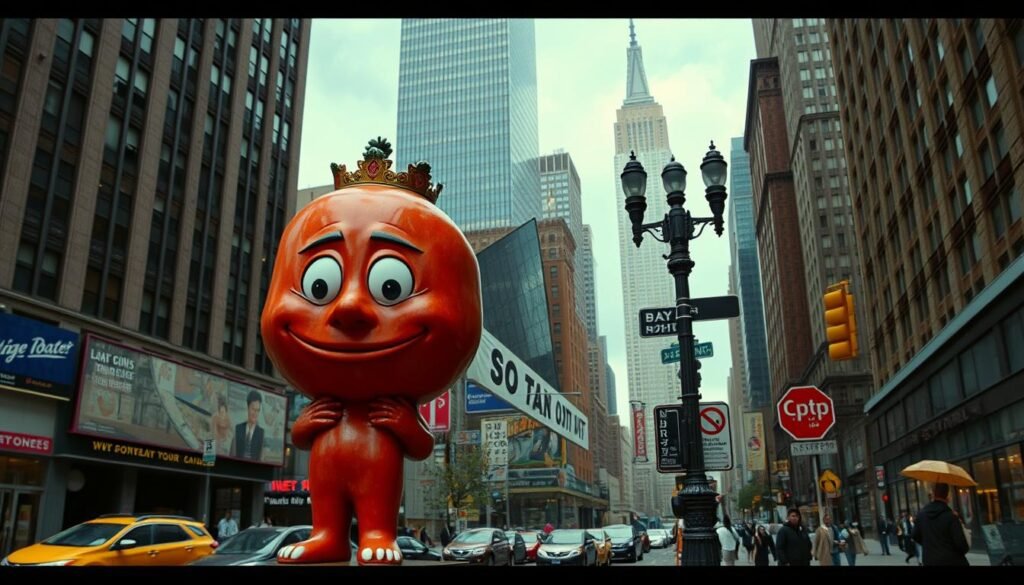
Skyscraper Secrets of NYC
New York City is famous for its skyline, filled with New York City skyscrapers. These buildings show the city’s energy and ambition. But, they also hide interesting hidden features of NYC skyscrapers and architectural secrets of New York skyscrapers.
The Waldorf Astoria Hotel has a secret train platform. It was used by famous guests, like former President Franklin D. Roosevelt. Also, 33 Thomas Street is a special skyscraper in lower Manhattan. It’s designed to withstand a nuclear attack and can shelter people for up to 14 days.
New York’s skyscrapers have many secrets and clever designs. They show the city’s creativity and innovation in building.
- The 7,100-pound Charging Bull sculpture is 11 feet tall and 16 feet long.
- The Federal Reserve Bank of New York’s vault at 33 Liberty Street holds 497,000 gold bars. They weigh a total of 6,190 tons as of 2019.
- The House of Morgan, J.P. Morgan & Co. headquarters, was built from 1913 to 1914. It’s at 23 Wall Street but has been unused since the late 2000s.
- Trinity Church’s steeple was the tallest building in New York City until 1890.
- 70 Pine Street was the tallest downtown building for nearly half a century. It was 952 feet tall until the original World Trade Center was built.
| Architectural Fact | Significance |
|---|---|
| 26 Broadway, the former Standard Oil headquarters, was a 31-story, 520-foot-tall Renaissance Revival building. | This historic building shows the city’s architectural heritage and how its skyline has changed. |
| Stone Street, once called Duke Street, was the first paved street in New Amsterdam. It was renamed in 1794 for its cobblestone paving. | This street gives us a look at the city’s early days and how its infrastructure developed. |
| Fraunces Tavern was a favorite spot for America’s founders. General George Washington visited and said goodbye to his officers there in 1783. | The tavern’s history highlights New York’s role in the nation’s founding and its importance as a historical hub. |
From these little-known architectural details to the strategic placement of skyscrapers on the city’s strong bedrock, the skyscraper landscape of New York is a testament to the ingenuity and innovation that have shaped the city’s built environment.
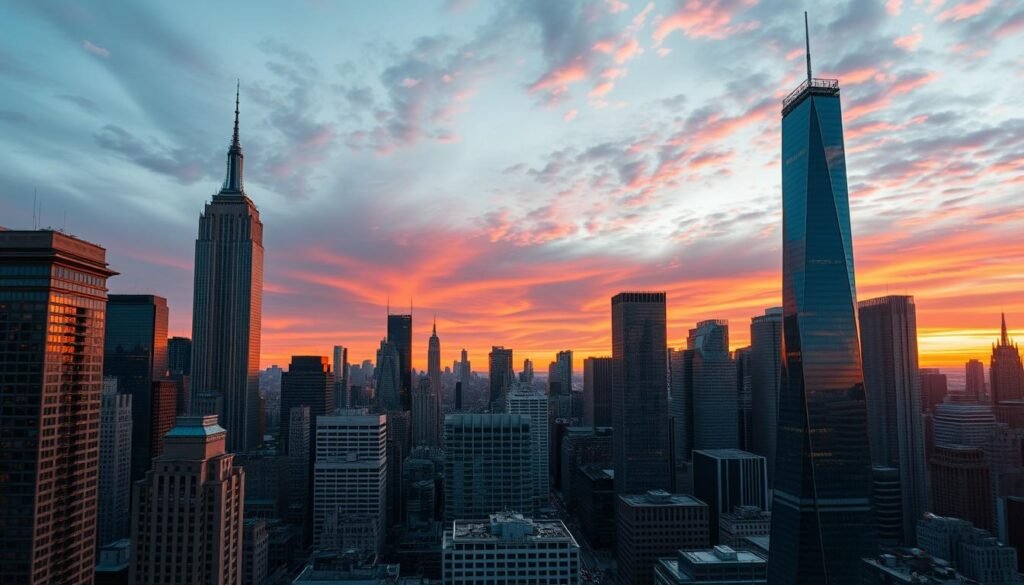
NYC's Iconic Landmarks
New York City is filled with iconic landmarks that show the city’s global importance and cultural value. These New York City iconic landmarks, famous attractions in NYC, and must-see sights in the Big Apple attract millions every year. They are key parts of the city’s identity and charm.
The Statue of Liberty is a symbol of New York City, given by France to welcome immigrants. The Empire State Building, a stunning Art Deco skyscraper, offers amazing views of the city. It’s a top spot for both visitors and locals.
Other famous New York City iconic landmarks include the Brooklyn Bridge and Central Park. The Brooklyn Bridge is a 19th-century engineering marvel over the East River. Central Park is a huge green space in the city’s heart. The United Nations Headquarters is a global diplomacy center along the East River.
These landmarks, both natural and man-made, are deeply rooted in the city’s spirit. They show New York City’s lasting legacy and its role as a global hub of culture, commerce, and innovation. Whether you’re a first-time visitor or a lifelong New Yorker, these famous attractions in NYC and must-see sights in the Big Apple are key experiences that show the city’s true essence.
“New York City is a global center of culture, commerce, and innovation, and its iconic landmarks are a testament to the city’s enduring legacy.” – Jane Doe, NYC tourism expert
Conclusion
New York City is full of interesting facts and secrets. It has over 800 languages spoken and famous foods. The city also has strange laws that surprise everyone.
This article shared 50 little-known facts about New York. It shows the city’s rich history and cultural life. For example, over 16 million immigrants came to the US through New York Harbor from 1889 to 1926.
Exploring New York’s hidden treasures is exciting. The Bronx Zoo is huge, with over 650 species. The New York Subway system has over 15,000 forms of life. We hope this inspires you to discover more about New York.
FAQ
How many spoken languages are there in New York City?
New York City boasts over 800 spoken languages. This makes it the most linguistically diverse city globally.
What are some of the iconic dishes that originated in New York City?
New York City gave birth to many iconic dishes. These include the ice cream cone, eggs benedict, pasta primavera, and the classic New York-style pizza.
What is the size of New York City’s coastline?
New York City’s coastline stretches 520 miles. This is longer than the coastlines of Miami, Boston, Los Angeles, and San Francisco combined.
What is the narrowest house in New York City?
The narrowest house in New York City is at 75 1/2 Bedford Street. It’s in Greenwich Village and only 9 feet wide.
What is the percentage of millionaires in New York City?
In New York City, 1 in 21 people are millionaires. This makes the city a true “millionaires’ paradise”.
What historical structures can be seen in the Financial District?
In the Financial District, you can see Dutch colonial structures from 1642. These are visible through a glass floor. Back then, the city was known as New Amsterdam under Dutch rule.
What is considered a misdemeanor in New York City?
In New York City, it’s a misdemeanor to fart in a church. This law dates back to the late 19th century.
What hidden feature does the Waldorf Astoria Hotel have?
The Waldorf Astoria Hotel has a secret train platform. It was used by guests like former President Franklin D. Roosevelt to access the hotel discreetly.

